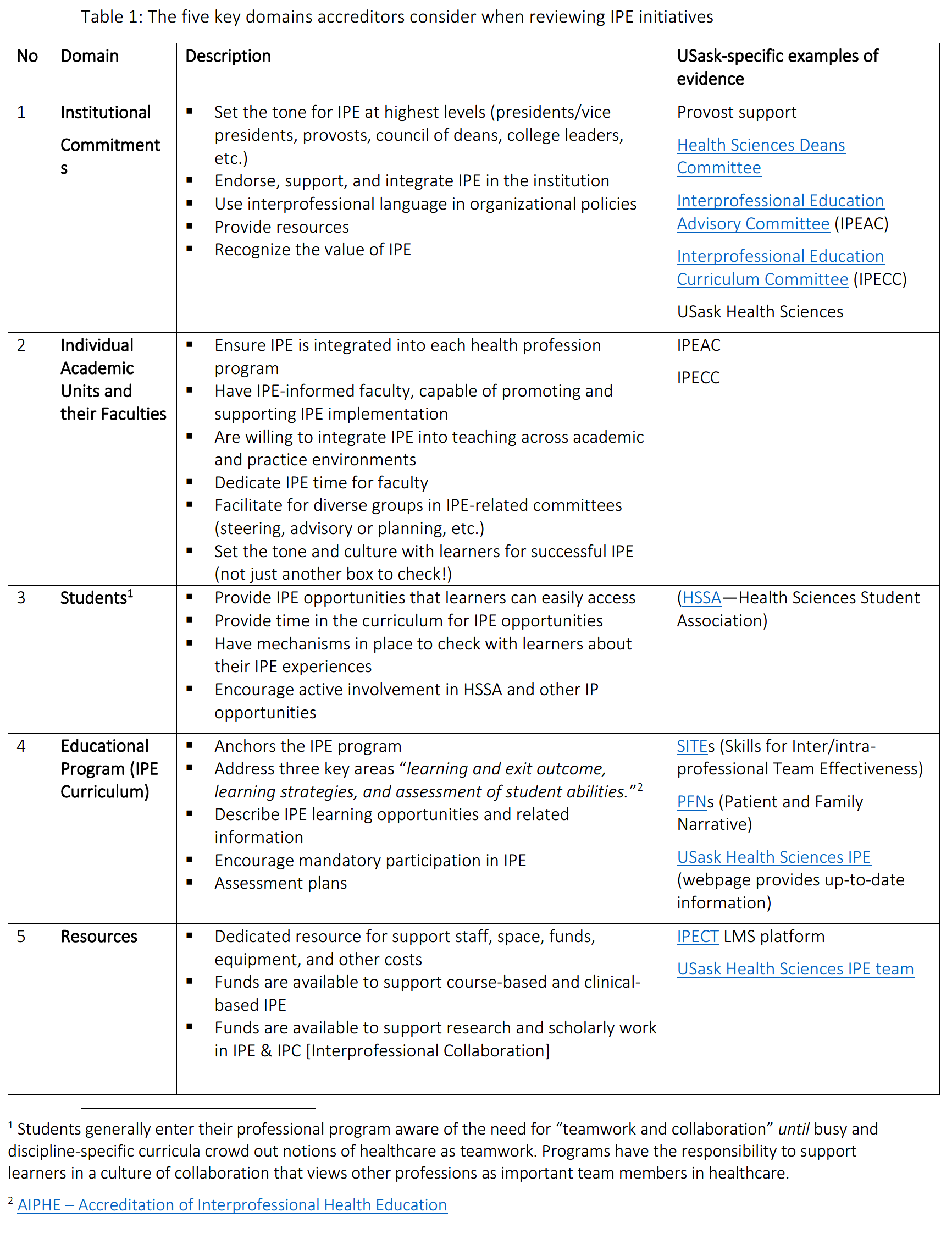
We want to go far, so we go together Post 5: Working together on IPE accreditation
Good IPE provides practice opportunities for learners and meets program accreditation requirements. This blog (1) highlights the role of accrediting bodies in supporting IPE, (2) sets out the key domains accreditors consider when evaluating IPE initiatives in health profession programs, (3) provides a summary table of the key domains with descriptors and examples, and (4) gives an example of how programs can work with the USask Health Sciences IPE team to prepare for accreditation. Estimated reading time: 4 minutes, 27 seconds.
By Charity Evans, Getahun Lombamo, and Sheryl MillsIntroduction
The healthcare system is continually evolving. Regardless of the profession, it is clear that interprofessional care, collaboration, and professional development are becoming increasingly important in practice. For this reason alone, it is critical that undergraduate healthcare programs provide students with interprofessional learning opportunities throughout their curriculums. Combine that with the fact that many programs now require interprofessional education (IPE) as part of their accreditation standards, and the need for a robust IPE plan is obvious.
Canada is ahead of many countries in having IPE-specific categories in accreditation standards in many of its health professions programs. Accreditation and regulatory bodies acknowledge and support the critical role of IPE in health profession education. These bodies integrate IPE-specific requirements in their accreditation standards for health professions programs and provide a framework for standard accreditation language for IPE.
Some Background
Health Canada funded a collaboration of six health profession programs, representing six accrediting bodies [AIPHE – Accreditation of Interprofessional Health Education], to work together and create guiding principles and practices for integrating IPE-specific requirements into their respective accreditation standards. The project had two phases. Phase 1 provided guiding principles, IPE specific standards and evidence as well as resources. Phase 2 of the group’s work created a guide to standard accreditation language for IPE. The intent was to assist accrediting bodies to use shared language across various professions when reviewing IPE-specific initiatives of training programs. The existence of “shared accreditation expectations for IPE” encourages collaboration among various professional programs and is an important step in supporting IPE initiatives.
IPE Domains and Evidence
The success of IPE in achieving the goal of producing “collaborative-practice-ready” workforce depends on factors within academic and training instructions that support or impede IPE initiatives. These factors include: (1) the leadership (at institutional, program specific and faculty levels), (2) faculty/instructors/staff engagement, (3) students, (4) the IPE curriculum, and (5) financial and other resources. Collectively these are referred to as the “IPE infrastructures”.
The AIPHE group suggests that accrediting bodies focus on these five key domains—infrastructures—when reviewing the quality of IPE in academic institutions. Table 1 provides a summary of these five key domains.

How we help your accreditation process
The USask Health Sciences IPE Team can support your accreditation process. Charity Evans (College of Pharmacy and Nutrition) provided this example:
The College of Pharmacy and Nutrition recently went through the accreditation process for our new Doctor of Pharmacy (PharmD) degree, where an entire standard is focused on demonstrating interprofessional learning experiences. Having a dedicated IPE unit within the University of Saskatchewan not only ensured we met the accreditation standard, but also provided us with all the necessary evidence and support required to establish this. In addition, the Accreditation Evaluation Committee met directly with the USask IPE team which allowed us to further highlight the important role that IPE plays in the PharmD program.
Please be in touch if you would like to discuss your IPE accreditation process: [IPE email]
These resources offer more on IPE accreditation:
(1) Accreditation of Interprofessional Health Education (AIPHE). (2011). AIPHE Interprofessional Health Education Accreditation Standards Guide: Phase 2 Funded by Health Canada. Accreditation of Interprofessional Health Education (AIPHE).
(2) Reeves, S., Fletcher, S., Barr, H., Birch, I., Boet, S., Davies, N., . . . Kitto, S. (2016). A BEME systematic review of the effects of interprofessional education: BEME Guide No. 39. Medical Teacher, 38(7), 656-668. doi:10.3109/0142159X.2016.1173663
(3) HPAC. (2020, December 18). Interprofessional Education Standards Survey. Health Professions Accreditors Collaborative (HPAC).
(4) Health Professions Accreditors Collaborative (HPAC). (2019). Guidance on developing quality interprofessional education for the health professions. Chicago, IL: Health Professions Accreditors Collaborative.

